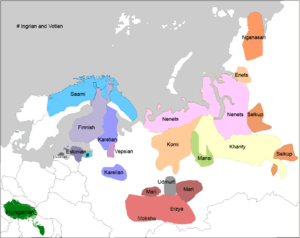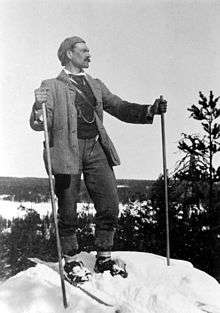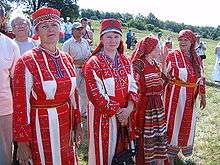Finno-Ugric peoples
| Total population | |
|---|---|
| ~26,505,000 | |
| Regions with significant populations | |
| 9,982,000 | |
| 4,948,400 | |
| 2,322,000 | |
| 2,288,100 | |
| 1,227,623 | |
| 936,000 | |
| 520,500 | |
| 507,600 | |
| ~450,000 | |
| 253,899 | |
| 156,600 | |
| 60,000–100,000 | |
| Languages | |
| Finno-Ugric, Russian, Tatar, Latvian, Romanian, Swedish, Norwegian | |
| Religion | |
| various Christian faiths | |
| Related ethnic groups | |
| Samoyedic peoples | |
The Finno-Ugric peoples are any of several peoples of Eurasia who speak languages of the Finno-Ugric group of the Uralic language family, such as the Khanty, Mansi, Hungarians, Maris, Mordvins, Sámi, Estonians, Karelians, Finns, Udmurts and Komis.[1]
Peoples
Existing Peoples

Extinct Peoples

The four largest Finno-Ugric peoples are the Hungarians (14,500,000), Finns (6,500,000), Estonians (1,000,000) and Mordvins (744,000). The first three of these have their own independent states – Hungary, Finland, and Estonia.
The traditional area of the indigenous Sami people is in Northern Fenno-Scandinavia and the Kola Peninsula in Northwest Russia and is known as Sápmi.
Some other Finno-Ugric peoples have autonomous republics in Russia: Karelians (Republic of Karelia), Komi (Komi Republic), Udmurts (Udmurt Republic), Mari (Mari El Republic), and Mordvins (Moksha and Erzya; Republic of Mordovia).
Khanty and Mansi peoples live in Khanty–Mansi Autonomous Okrug of Russia. Komi subgroup Komi-Permyaks used to live in Komi-Permyak Autonomous Okrug, but today this area is a territory with special status within Perm Krai.
Finno-Ugric identity
In Finnic- and Ugric-speaking countries such as Finland, Estonia and Hungary that find themselves surrounded by unrelated tongues, language origins and language history have long been relevant to national identity.[4]
Vladimir Lenin may have had Mordvin ancestry.[5]
Boris Yeltsin had Mansi ancestry.
Some Estonians and Finns believed that Vladimir Putin is potentially of Finno-Ugric ancestry, however some Russians may take it as an offense to be accused of being of Finno-Ugric descent.[6]
Mythology
Shamanism has had a historically important influence on the mythologies of Siberian peoples, including the Finnic, Ugric, Yeniseian, Turkic, Mongolic, Tungusic, and other northern Eurasia and Central Asian peoples. A central concept in their cosmologies is the myth that the world was created from an egg. There are also myths about the Milky Way, ideas about the existence of the World tree or pillar, and the idea that asterisms represent animal spirits.[7] A myth about a bird floating on the primary ocean that dives for the ground is a central Uralic cosmogonic myth.[8]
International Finno-Ugric societies
Established in Syktyvkar in 1992,[9] the World Congress of Finno-Ugrian Peoples is convoked at least once in four years.[10] The members of the Finno-Ugric Peoples' Consultative Committee include the Erzyas, Estonians, Finns, Hungarians, Ingrian Finns, Ingrians, Karelians, Khants, Komis, Mansis, Maris, Mokshas, Nenetses, Permian Komis, Saamis, Tver Karelians, Udmurts, Vepsians; Observers: Livonians, Setos.[11]
The first Festival of the Finno-Ugric Peoples was held in Yoshkar-Ola in 1990. The tradition continued covering turn by turn all regions of the Finno-Ugric world: the Republic Mari El, Mordovia, Hanty-Mansijsk, Estonia, Udmurtia, Hungary.[12] In 2007 the festival was hosted by the President of Russia and visited by the leaders of Finland and Hungary, Finnish President Tarja Halonen and Hungarian Prime Minister Ferenc Gyurcsány.[13]
Population genetics
A study of Population Genetics of Finno-Ugric speaking humans in North Eurasia carried out between 2002–2008 in the Department of Forensic Medicine at the University of Helsinki showed that most of the Finno-Ugric speaking populations possess an amalgamation of West and East Eurasian gene pools, genetic drift, and recurrent founder effects. North Eurasian Finno-Ugric-speaking populations were found to be genetically a heterogeneous group showing lower haplotype diversities compared to more southern populations. North Eurasian Finno-Ugric-speaking populations possess unique genetic features due to complex genetic changes shaped by molecular and population genetics and adaptation to the areas of Boreal and Arctic North Eurasia.[14]
The proposal of a Finno-Ugric language family has led to the postulation not just of an ancient Proto–Finno-Ugric people, but that the modern Finno-Ugric–speaking peoples are genetically related.[15] Such hypotheses are based on the assumption that heredity can be traced though linguistic relatedness.[16] However, Finno-Ugric has not been reconstructed linguistically; attempts to do so have been indistinguishable from Proto-Uralic.[17] Like in any other human population, individual groups within the Finno-Ugric language family have a diverse array of cultural, environmental, and genetic influences. However, modern genetic studies have shown that the Y-chromosome haplogroup N3, and sometimes N2, having branched from haplogroup N, which, itself, probably spread north, then west and east from Northern China about 12,000–14,000 years ago from father haplogroup NO (haplogroup O being the most common Y-chromosome haplogroup in Southeast Asia), is almost a specific trait, though certainly not restricted, to Uralic- or Finno-Ugric-speaking populations, especially as high frequency or primary paternal haplogroup.[18][19]
A recent study has found that haplogroup NO of the Finno-Ugric peoples and their descendants probably spread north, then west and east from Northern China about 12,000–14,000 years ago from its father lineage and today is found in Eastern Europe.[20] The Department of Forensic Medicine at the University of Helsinki showed that most of the Finno-Ugric speaking populations possess an amalgamation of West and East Eurasian gene pools, supporting the idea of mixed origins in these modern populations.[14]
R1a1a7-M458
R1a1a7-M458 frequency peaks among Slavic and Finno-Ugric peoples.[21]
R1a1a1i (Z280+)
This group seems to have connection with among others the Finno-ugric peoples.[22] It is the North-East European subclade of R1a1a1 and spread from the Baltic to the Ural Mountains as well as the Carpathian Basin. The majority of the Steppe Magyars likely belonged to this haplogroup, carrying the Ugric Hungarian language.[23]
Archaeology
Gallery
-

Finnish artist, Akseli Gallen-Kallela
-

Izhorian oral poet, Larin Paraske
-

Karelian women in Sammatus
-

From left to right: Sven-Roald Nystø, Aili Keskitalo and Ole Henrik Magga, the second, third and first president of the Norwegian Sámi Parliament
-

Khanty women in Man uskve nomad camp, Berezovsky, Khanty-Mansia, Russia
-

Hungarian Prince Árpád crossing the Carpathians into modern-day Hungary
-

A Székely village in Romania
-

A Sami family around 1900
-

Sami woman
-

Erzya women
-

Komi people
-

Estonian poet Lydia Koidula
See also
References and notes
Sinor, Denis (1990). The Cambridge History of Early Inner Asia. Cambridge University Press. pp. 229–252. ISBN 0-521-24304-1.
- ↑ Peter Hajdu, 1975, Finno-Ugrian Languages and Peoples, Andre Deutsch Ltd (translated by G.F. Cushing); Toivo Vuorela, 1997, The Finno-Ugric Peoples, RoutledgeCurzon
- ↑ Korhonen, Mikko: Uralin tällä ja tuolla puolen. In the book Laakso, Johanna (edit.): Uralilaiset kansat, p. 23.
- 1 2 3 4 5 6 7 8 9 Demoskop Weekly No 543-544
- ↑ "A 'Paradigm Shift' in Finnish Linguistic Prehistory". Merlijn de Smit. ButterfliesandWheels.com. 2003. Retrieved 2009-03-07.
- ↑ Liliana Riga (12 November 2012). The Bolsheviks and the Russian Empire. Cambridge University Press. pp. 259–. ISBN 978-1-107-01422-0.
- ↑ http://www.iltasanomat.fi/ulkomaat/art-1288336663684.html
- ↑ Leeming, pp. 136
- ↑ Vladimir Napolskikh. Earth-Diver Myth (А812) in northern Eurasia and North America: twenty years later
- ↑ Council of Europe (2007). Parliamentary Assembly. Council of Europe. p. 162. ISBN 92-871-6191-7.
- ↑ "Statutes of the Consultative Committee of Finno-Ugrian peoples". Finno-Ugric Peoples' Consultative Committee. Retrieved 2009-03-05. Check date values in:
|date=(help) - ↑ "Finno-Ugric Peoples' Consultative Committee, Members". Finno-Ugric Peoples' Consultative Committee. World Congresses of the Finno-Ugric Peoples. Retrieved 2009-03-05.
- ↑ "IX International Festival of the Finno-Ugric Peoples". Ministry of Culture of the RK. 24 May 2001. Retrieved 2009-03-05.
- ↑ Herald Tribune (July 19, 2007). "Putin hosts leaders at Finno-Ugric festival". Retrieved 5 March 2009.
- 1 2 Pimenoff, Ville (2008). Living on the edge: population genetics of Finno-Ugric-speaking humans in North Eurasia. Department of Forensic Medicine, University of Helsinki. pp. 27–28. ISBN 952-92-4331-6.
- ↑ Sámuel Gyarmathi (1 January 1983). Grammatical Proof of the Affinity of the Hungarian Language with Languages of Fennic Origin. John Benjamins Publishing. p. 7. ISBN 90-272-0976-6.
- ↑ Origin of Finnish and related languages- thisisFINLAND
- ↑ Salminen, Tapani (2002): Problems in the taxonomy of the Uralic languages in the light of modern comparative studies
- ↑ European Journal of Human Genetics – Abstract of article: A counter-clockwise northern route of the Y-chromosome haplogroup N from Southeast Asia towards Europe
- ↑ "Journals Home" (PDF). Journals.uchicago.edu. Retrieved 2014-01-16.
- ↑ Siiri; et al. (2007). "A counter-clockwise northern route of the Y-chromosome haplogroup N from Southeast Asia towards Europe". European Journal of Human Genetics 15 (2): 204–211. doi:10.1038/sj.ejhg.5201748. PMID 17149388.
- ↑ European Journal of Human Genetics. "European Journal of Human Genetics - Separating the post-Glacial coancestry of European and Asian Y chromosomes within haplogroup R1a". Nature.com. Retrieved 2014-01-16.
- ↑ Joseph Pashka, poshka@hotmail.com (2008-11-17). "BALTIC LANGUAGES & PROTO-BALTIC | The Baltic & Uralic in Vedic | Balto-Slavic | Uralic Soma |". Suduva.com. Retrieved 2014-01-16.
- ↑ "Hungarian_Magyar_Y-DNA_Project". Family Tree DNA. Retrieved 2014-01-16.
Further reading
- Mile Nedeljković, Leksikon naroda sveta, Beograd, 2001.
- People of Volga and Uralic regions. Komi-Zyrians. Komi-Permyaks. Mari. Mordvins. Udmurts. Moscow, 2000. (Russian: Народы Поволжья и Приуралья. Коми-зыряне. Коми-пермяки. Марийцы. Мордва. Удмурты. М., 2000.)
- Petrukhin, Vladimir. Myths of Finno-Ugric Peoples. Moscow, 2005. 463 p. (Russian: Петрухин В. Я. Мифы финно-угров. М., 2005. 463 с.)
- World Outlook of Finno-Ugric People. Moscow, 1990. (Russian: Мировоззрение финно-угорских народов. М., 1990.)
External links
| Wikimedia Commons has media related to Finno-Ugric peoples. |
- URALIC PEOPLES
- MORDVINS (Erzyas and Mokshas)
- MARIS or Cheremisses
- VEPSIANS
- The Information Center of Finno-Ugric Peoples (SURI)
- The Information Center of Finno-Ugric Peoples (SURI) Newsletter: "Uralic Contacts"
- Kindred Peoples Programme
- Etnofotu (Ethnofuturism)
- The International Congress of Finno-Ugric Writers
- The Youth Association of Finno-Ugric Peoples (MAFUN)
- International Expedition for high school, college and university students of the Finno-Ugric World
- Finno-Ugric Student's Seminar Camp
- Mari Association of Finno-Ugric Peoples
- Federal Finno-Ugric Cultural Center (Sykytyvkar, Komi Republic)
- Article on plans for new Federal Finno-Ugric Cultural Center in Sykytyvkar, Komi Republic
- International Finno-Ugric Students' Conference (IFUSCO)
- The International Festival of Theatres of Finno-Ugric Peoples
- World Championship of Kalevala Chanting & Ugric Rumble Ethno Music Festival
- Uralkult Festival: "Finno-Ugric culture now!"
- Ugriculture: Contemporary Finno-Ugric art at the Gallen Kallela Museum
- On the Banks of the Volga: "Life of a Finno-Ugrian people past and present"
- Bearslaying Theatre Festival: Theatre by Finno-Ugric Peoples
- University of Indiana Bloomington |Central Eurasian Studies: Uralic Peoples
- Finno-Ugric media center
| ||||||||||||||||||||||||||||||||||
